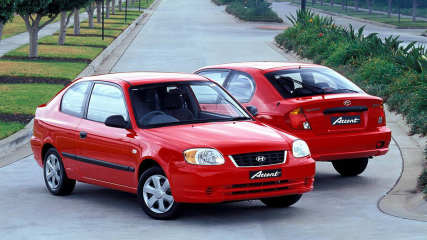Used Hyundai Accent review: 2000-2012
By Ewan Kennedy · 26 Apr 2013
Hyundai Accent arrived in Australia in June 2000 to replace the extremely successful Hyundai Excel. Hyundai attempted to push it a bit more upmarket than the Excel and that included a price rise that took it out of the cheap-and-cheerful category. The lower cost Hyundai Getz also stole sales from Accent.So sales of the Accent have never been as high as the Korean importers planned, but there are plenty on the used-car market and if you shop around there are some excellent buys out there.Hyundai’s build quality, which was a bit hit-and-miss in the company’s earlier years, had improved noticeably and the Accent benefited from being an all-new design. The later the car you buy the better it’s likely to be. The main structure of the Accent generally holds up well when subjected to the rigours of rough Aussie roads. Anything that squeaks and/or rattles, particularly inside the cabin, during your test drive should be treated with suspicion.There's good interior room in this small-medium Hyundai and buyers with pre-teen children can use the Accent as a full family car. The boot is roomy and easy to use and has a good shape that’s reasonably easy to load.Hyundai's Accent has good handling and the feel through the steering is better than average for an Asian import. There's some understeer if you push hard but the car is reasonably neutral until then. A good set of tyres can markedly improve things in the handling department and won’t set you back a huge amount of money.Model choices are quite limited because slow sales meant that the upmarket Accent hatchbacks, and all sedan variants were pulled off the Australian market in 2002. The sedan made a return in May 2006 with the introduction of a virtually all-new Accent.In September 2003 the Accent received a facelift to move it away from the somewhat bland look of the original model. This facelifted version is more popular on the used scene and it’s worth paying the extra if you’re looking for a bit of pizzazz in an affordable car.At the time of the 2003 body revamp, the Accent’s engine was increased in size from 1.5 to 1.6 litres. Performance from the new 78 kW unit made the small-medium Hyundai reasonably zippy on the road. It’s still not really sporting, but the car became more pleasant to drive, with shorter overtaking distances and the ability to climb hills with fewer gearchanges.Gearbox options are five-speed manual and four-speed automatic. This means it’s lagging behind more recent competitors with multi-speed manuals and autos. The manuals are generally good in their gearchanges but can bind up at times for no obvious reason. Automatics do sap a fair bit of engine power in a car of this size and are probably best left to those who do a lot of heavy-duty commuting in serious traffic.These days Hyundai is a fully established as part of the Australian automotive scene. The dealer network is large and widespread, though as is often the way in a car in this class, representation in the bush can be on the sparse side. We have heard of no real complaints about the cost of servicing or spare parts.The Accent is a simple design and has good underbonnet space, so it’s easy enough to work on. A lot of routine work can be done by a good home handyperson, though safety related items should be left to the professional. It’s always a good idea to have a workshop manual on hand before starting your own servicing and repair work.Insurance charges are moderate and there doesn’t appear to be a great deal of difference between companies as to the premiums they charge. Shop around but, as always, make sure you are doing a full apples-with-apples comparison before making your final choice.WHAT TO LOOK FORWe have seen Accents reach 200,000 km without any real problems. These cars had obviously been driven sensibly and serviced by the book - ask to see the full service records. Look over the interior, including the boot, for signs of rough usage. This may be a sign that other out of sight areas have also been mistreated.Rust isn't normally a problem, but look at all the lower body areas and around the front and rear windscreens to be safe. Any cars we have seen with rust in their bodies have been poorly repaired after crashes.Do an engine check for easy starting and smooth idling. Where possible this should be done with the engine cold, preferably after it has been sitting overnight.Feel for a manual gearbox that baulks during fast gear changes, especially during the three-two down change.Turn the steering wheel all the way from one side to the other whilst travelling at a very low speed and listen for clunking noises near the front wheels. These probably indicate the universal joints are worn.CAR BUYING TIPSellers will ask more for cars with a full service history, but it’s generally worth the extra outlay. Having paid the higher price it’s smart to keep its logbooks up to date. That way you can get most of your added investment back when it’s time to trade up.










